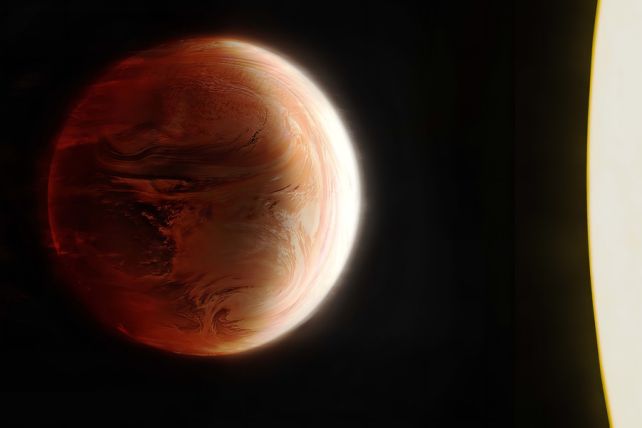The tiny pebbles left over from a star’s formation fed the growth of one of the strangest, wildest worlds humanity has ever known.
It’s a famous one, Tylos, or WASP-121b, a gas giant exoplanet some 880 light-years away, so close to its host star that its atmosphere is filled with clouds of vaporized metal.
Now, new observations show that this world – one of the most studied in the Milky Way – was constructed from the dust and rocks that circled the star, back when the system was still in its early formative years.
The smoking gun? Silicon monoxide – clouds of vaporized rock. Using JWST, a team of astronomers identified the molecule in the exoplanet’s atmosphere, in addition to water, carbon monoxide, and methane.

“The relative abundances of carbon, oxygen, and silicon offer insights into how this planet formed and acquired its material,” explains astronomer Thomas Evans-Soma of the University of Newcastle in Australia, who led the research.
Tylos is around 1.75 times the radius but only 1.16 times the mass of Jupiter, orbiting a yellow-white star named Dilmun that’s 1.5 times the radius of the Sun, on a breakneck orbit of just 30 hours. It’s so close to the star that it’s literally evaporating, its atmosphere puffed up by the intense heat.
As it whips around Dilmun, Tylos passes between us and it, which means it’s in the perfect configuration for study. Some of the star’s light passes through the exoplanet’s puffy atmosphere and becomes altered by the molecules therein as it goes. Astronomers can painstakingly study these tiny signals to figure out which molecules are responsible for the alterations.

Tylos is what is known as a hot Jupiter – gas giant worlds in bogglingly close proximities to their host stars. They’re something of an open question: they can’t form in those close orbits, because the radiation and winds from the star would stop the gas from accumulating. The leading explanation is that they form farther away and migrate inwards.
The first detection of silicon monoxide in an exoplanet’s atmosphere was described in a paper published in 2022. It’s a very difficult and rare molecule to detect. But it’s the combination of molecules in the atmosphere of Tylos that helped Evans-Soma and his team figure out the exoplanet’s birthplace.
Stars are born from dense clouds of molecular gas. As they spin, material arranges itself in a disk that spools into and feeds the growing star. Once the star is powerful enough to push away the material with its winds, its growth is cut off, and the material that’s left in the disk clumps in small pebbles of dust and ice that stick together and grow to form planets.
frameborder=”0″ allow=”accelerometer; autoplay; clipboard-write; encrypted-media; gyroscope; picture-in-picture; web-share” referrerpolicy=”strict-origin-when-cross-origin” allowfullscreen>
At closer proximities to the host star, ice sublimates into gas. This is known as the ice line or the snow line, and different ices have different sublimation points.
Studying the ratios of the molecules in the atmosphere of Tylos, the researchers concluded that the exoplanet formed at a distance from its star where methane was in its vapor form, but ice remained frozen.
In the Solar System, that distance is out between the orbits of Jupiter and Uranus. Dilmun is hotter than our Sun, so the distance would be even greater for Tylos – suggesting that it had to migrate a long way to get to its current position. It’s also some of the best evidence yet for how hot Jupiters form and evolve.
But there’s another mystery. The methane was detected on the exoplanet’s nightside, which faces permanently away from Dilmun. Methane is unstable at high temperatures, and would be undetectable on the scorching dayside. As it moves around into the nightside, it’s expected to remain undetectable at the same altitude.
frameborder=”0″ allow=”accelerometer; autoplay; clipboard-write; encrypted-media; gyroscope; picture-in-picture; web-share” referrerpolicy=”strict-origin-when-cross-origin” allowfullscreen>
The plentiful abundance, therefore, of methane high in the nightside atmosphere of Tylos suggests some interesting atmospheric processes going on. The researchers think it’s vertical mixing – strong updrafts carrying methane from deep in the atmosphere to the upper atmosphere, where it can be detected by JWST.
“This challenges exoplanet dynamical models, which will likely need to be adapted to reproduce the strong vertical mixing we’ve uncovered on the nightside,” Evans-Soma says.
Although we’ve peered at Tylos more than most of the nearly 6,000 exoplanets confirmed to date, the strange, melting world still has a lot to teach us about planets in the Milky Way.
The research has been published in Nature Astronomy.


8 Comments
zysipl
Good shout.
live rosin gummies area 52
AR
BI
live resin carts area 52
where to buy thca area 52
thc gummies